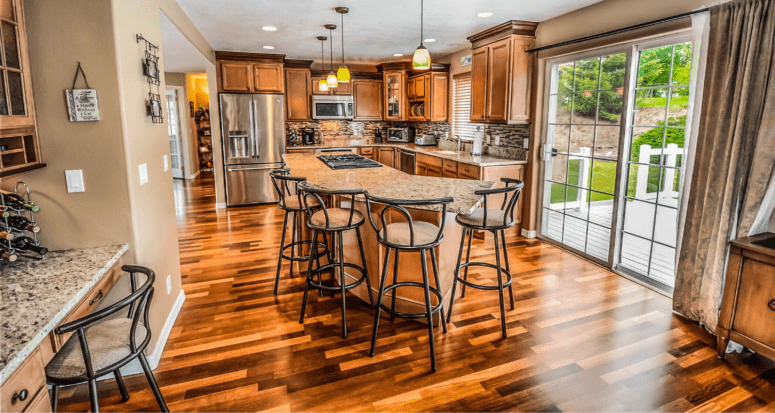How Does Buying a House Work? 3 Real-Life Examples
- Published on
- 5 min read
-
 Vanessa Nirode Contributing AuthorClose
Vanessa Nirode Contributing AuthorClose Vanessa Nirode Contributing Author
Vanessa Nirode Contributing AuthorVanessa is a NYC based writer. She’s bought and sold a few houses in her day and was raised by an avid DIY-er. She’s written for Gadget Hacks, BBC Travel, Fodors, Bluprint, and many others. In her spare time she works as a tailor and pattern maker for film and TV.
Ever wonder how buying a house actually works?
While every home purchase experience is unique, most people follow the same basic steps in essentially the same order: Get a preapproval on a mortgage so you know how much you can afford, find a real estate agent, put an offer on a house, get a home inspection, appraisal, survey, and title search, finalize all loan documents, close on the home, and move in. Sounds simple, right?
No matter how many house-buying checklists and step-by-step articles you read, they won’t be able to prepare you for every possible scenario in the homebuying process. And many of them don’t touch upon what it feels like to buy a house. Because no matter how hard you try, emotions will likely come into play.
We researched and talked to expert real estate sources as well as listened to stories and advice from people who bought their first home in 2018 or 2019 to put together this resource about one of life’s biggest decisions: Buying your first home.

Understanding the homebuying process
Buying a house can be one of life’s most stressful events.
Shal Shahani, a top-selling Boston real estate agent and single-family home expert who has worked with 80% more single-family home transactions than the average agent in the area, helps a wide variety of people find and purchase homes. Shahani says that the mortgage preapproval process and finding a real estate agent can happen simultaneously.
“Since agents have a good understanding of what banks and mortgage companies are looking for, they’re able to offer sound advice on potential markets and lenders,” she explains.
“If the buyer has a bank they normally bank at, we would go and talk to the mortgage person first,” Shahani says. Otherwise, buyers should talk to their agent to get an idea of what they need to do and where they want to be.
Titles and closings
Title searches are a necessary step in the homebuying process. A title search makes sure that all documents and transactions concerning the property in question were filed and executed properly, and it also searches for any liens on the home.
Most lenders require title insurance, which protects their interests (loan amount) in the property, but not the homeowner’s interests (or equity). Equity is the dollar value you’re left with after you subtract the amount of your mortgage from the sales price or market value of your house. Many buyers choose to take out an additional owner’s title insurance policy to protect that equity.
Shahani told us of a recent title search that uncovered a missing signature from 70 years ago on a document. The property was owned by a couple; one of them died, so when it was sold, the document was missing the signature of the deceased. This meant that whoever inherited the property could conceivably make a claim that the sale from the remaining parent to the buyer wasn’t legitimate.
“Luckily,” Shahani explains, “the sellers had title insurance on the house, so the title company came in and went to the courts.” Something like this could (and in this case, did) delay a closing for a few weeks.
Title insurance policy costs vary depending on the amount of the loan, the state the property is located, and the buyer’s credit score. Also, different banks and lenders may offer different rates. Lower credit scores and higher loan amounts are considered riskier and could result in higher premiums.
The average cost of lender’s title insurance, based on a $200,000 home in California with a buyer credit score of 740, is $544. The average homeowner’s cost for title insurance of the same home is $830.
Other examples of problems that could delay a closing include not submitting all your mortgage documents in time for review or the lender failing to send the Closing Disclosure out in time. Shahani also had a closing delayed for two months because of a failed septic system on the property in question.
Getting everything in place for a closing can be challenging at times, and it’s virtually impossible to plan for every scenario. Here are some recent new homeowners who told us how (and why) they bought their first home.

Example 1: Putting down roots
Jamie Birdwell-Branson, freelance editor and writer
Bought: Toledo, Ohio, June 2018
Purchase price: $169,900
Down payment: 5% or $5,097
In order to avoid private mortgage insurance, Jamie Birdwell-Branson and her husband applied for a government loan (FHA, VA, or USDA) and put down 5% of the sales price of their new home. Some of these programs have their own form of mortgage insurance, but it is generally less expensive than the private mortgage insurance offered with a conventional loan.
“We saved up money,” she says, “by just putting weekly installments in our savings account as well as taking on extra gigs or side hustles to complement what we make regularly.”
Birdwell-Branson searched for about two months for a home. “I was starting to get discouraged because I had my sights set on one particular neighborhood and nothing was really grabbing us,” she explains. “The neighborhood is very old, and so many of the homes were fixer-uppers or just really outdated aesthetically.”
Just as they were ready to give up on the neighborhood, Birdwell-Branson’s real estate agent told her about a house she was about to list for one of her other clients, a house she was sure Birdwell-Branson and her husband would love. As it turned out, they did.
The couple switched real estate agents at this time to ensure a fair transaction for all involved (so that the same agent wasn’t representing both the buyer and seller). While the closing was quick and easy, they experienced some disappointment when they discovered that, in Toledo, sellers are allowed to negotiate that they remain in the house for up to 30 days after closing.
“It was really frustrating to have to pay our mortgage and not be able to move in,” Birdwell-Branson notes.
A couple of months after moving in, the couple discovered that, while the seller had disclosed that the basement had flooded in the past, they hadn’t indicated that it was actually a persistent pattern.
“We had to pay for waterproofing, which, at $12,000, was very expensive. But I love the house so much that honestly, at the end of the day, it’s not that big of a deal. Basically, you just have to be prepared to pay up when your home needs major repairs,” Birdwell-Branson says.
Her favorite thing about homeownership? Finally having roots someplace. “My husband and I have lived in five different states, and it’s nice to finally have somewhere we can call our own.”

Example 2: Offering over asking
Caroline, content marketing editor
Bought: West Des Moines, Iowa, June 2018
Purchase price: $270,500
Down payment: 15% or $40,575
Caroline and her then-boyfriend, now-fiance, started saving up for their down payment about two years before they were ready to buy. “We didn’t have any financial support from family or friends,” Caroline explains, so they saved by “just tucking away money from each of our paychecks month-to-month.” Renting a townhouse in an affordable city and working from home helped maximize those savings deposits.
When they were ready to start looking for a house, their timeline coincided with the spring buying season and they looked at about a dozen homes between March and April without seeing anything that seemed like a perfect fit. But their agent was keeping an eye out for homes and told them about one that was about to hit the market in an older, established neighborhood; Caroline and her fiance toured it, “And the moment we walked into the house, we fell in love with it. That night, we made an offer for $500 over asking, to encourage the sellers to go with us rather than try to drive up a bidding war with other buyers.”
They got the house — but there were some unforeseen expenses that emerged after closing. Fixing the garage door lift and repairing the washing machine cost several hundred dollars apiece, but the big ones involved a tree in the yard and older plumbing (the house was built in 1973). “About a year after we moved in, we found out the large ash tree in the front yard was infected and would require removal — around $3,000.” And the copper pipes in the home were corroding, which caused plumbing leaks that had to be addressed.
“We are planning a bathroom remodel to expand the master shower and repair some of that plumbing all at once, an investment of around $20,000.”
In retrospect, Caroline says she wished she would have dipped a little further into savings or asked family for help to scrape together the remaining 5% down to avoid private mortgage insurance. And she advises buyers to consider moving slowly, even in a hot market. “That feeling of wanting a house and knowing you can lose it to other buyers can be overwhelming,” she notes.
“However, it’s really important to slow down, do all of your inspections, and negotiate where you can before the deal closes, even in a seller’s market.”
Despite the expenses, though, they’re happy in their home. “Buying a home so far has been 100% worth it,” she says. “We’re building equity, enjoying so much more space and privacy than we had in a townhome, and we have a wonderful fenced backyard for our golden retriever.”

Example 3: Research and commitment
Kate
Bought: New York, New York, 2019
Purchase price: $600,000
Down payment: 20% or $120,000
When Kate and her partner put an offer in on their home, they’d only really been casually looking. Shopping for a house can be “quite fun if you’re not under pressure or in a bind,” she notes.
Kate and her partner began their search with a real estate agent who was a friend, which eased any fears they might have had about being “led down a path they wouldn’t be comfortable with.”
The two shoppers conducted a lot of research before even starting to look: About where they wanted to live, what they could realistically afford, how long they wanted to spend there, what it would be like to own property, what renovations they might want to do, and how much those would cost.
“As an architect, I knew we wanted something that wasn’t totally new and renovated, but rather something that had potential — lots of good light, a nice layout, and good bones, something that might need some work that we could do in part ourselves and in part by local contractors.”
For Kate and her now-husband, a big part of their desire to own a house together was about “cementing our relationship and showing each other (and our families!) that we were serious and committed to each other.”
The couple had been together for four years, cohabitated for two, and purchasing a home was, for them, the next step. They didn’t have any real interest in having a big wedding.
“Purchasing a home together was a commitment that bound us financially, spatially, and legally and was a meaningful step in our relationship, even if doing so before getting married was perhaps unorthodox in some communities,” Kate says.
Image Header Source: (Pixabay / Pexels)
